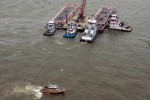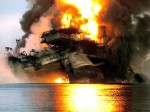Galveston Re-opens to Vessel Traffic, Oil Still Being Cleaned Up
by News Editor / Newsroom Ink March 26, 2014

A Coast Guard response boat patrols the Kirby Barge 27706 during cleanup efforts near the Texas City Dike. The oil spill occurred after a collision between a bulk carrier and the barge. Photo: U.S. Coast Guard
by Ed Lallo/Gulf Seafood News Editor
Fishing operations have been greatly reduced in Galveston Bay over the past few days due to channel restrictions as works continues to contain a spill that occurred when a barge carrying almost 1 million gallons of heavy oil collided with a ship near Houston.
Galveston Bay, and the Houston ship channel, is home to the largest U.S. petrochemical port in to the Gulf of Mexico.

“This is just a stupid mistake that could have been avoided,” said Galveston fisherman Buddy Guindon, owner of Katie’s Seafood House, which sells fresh Gulf seafood. “We have oil everywhere; on the docks, the boats, it’s just a big mess.” Photo: Ed Lallo/Newsroom Ink
“This is just a stupid mistake that could have been avoided,” said Galveston fisherman Buddy Guindon, owner of Katie’s Seafood House, which sells fresh Gulf seafood. “We have oil everywhere; on the docks, the boats, it’s just a big mess.”
The leaking barge was carrying approximately 168,000 gallons of bunker oil — a tarry, heavy fuel used in Marine vessels. It has spilled an unknown amount into the Houston Shipping Channel since the collision last Saturday.
“The remaining oil has been transferred off of the damaged barge and it has been removed from the channel,” said Greg Beuerman, a spokesman for the Unified Command Joint Information Center, and a Gulf Seafood Institute board member. “More than 70 vessels are on the water assisting in the clean up, and approximately 70,000 feet of boom has been deployed in sensitive areas.”
During the clean up efforts there have been no use of dispersants like the controversial corexit used during the Deepwater Horizon cleanup efforts in the Gulf.
“The channel has been almost completely shut down until today,” explained Guindon, who bought his last fresh shrimp on Saturday. “ Nobody has been able to move within the port. Shrimpers and other fisherman have been forced to sit idle.”
“The remaining oil has been transferred off of the damaged barge and it has been removed from the channel,” said Greg Beuerman, a spokesman for the Unified Command Joint Information Center, and a Gulf Seafood Institute board member. Photo: BFM
The Houston ship channel reopened to limited daytime traffic on a priority basis as of 2 p.m. on Tuesday, with limited access to the spill area from Channel Buoy 40 to Channel Buoy 3.
The spill forced Guindon to divert one of his fishing boats, “We had to send one of our boats to Freeport. It was scheduled to unload more than 26,000 pounds of snapper and grouper here in Galveston, but that just didn’t happen,” he said.
The spill has also affected the bay oyster harvest.
In a letter to its customers, Sysco Louisiana Seafood’s Johnny Elgin, director of quality assurance, said the company has not received any affected lots related to the closure. In order to minimize disruption, the company has made arrangements to secure product from alternative approved sources.
According to Beauerman, as of late Tuesday all vessel traffic and channels and Ports have been reopened, although mariners are urged to proceed with caution. Private vessel cleaning stations will also be made available. “Boat owners can call 832-244-1870 to schedule decontamination,” he said.
After the oil is removed he is not sure how long it will take for him to get back into business. “I haven’t even taken an extensive look at how much oil there is around our dock, or how hard it will be to clean up,” he said. “I just know that it is a mess, and I am not looking forward to the task ahead.”
Special thanks to Ed Lallo/Gulf Seafood News



